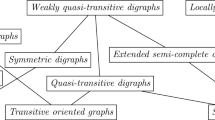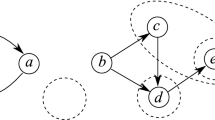Abstract
This paper introducesextended clause graph resolution, a variant of Kowalski's clause graph resolution that is terminating at the full first-order level. This terminating variant is obtained by extending the definitions of clause graph and clause graph resolution to include more information about the interdependencies between links and clauses in the graph, by restricting purity slightly and by employing an exhaustive search of eligible links.
Similar content being viewed by others
References
Andrews, P. B. (1968): Resolution with merging,J. ACM 15, 367–381.
Andrews, P. B. (1976): Refutations by mating,IEEE Trans. Computing C-25, 801–807.
Andrews, P. B. (1981): Theorem proving via general mating,J. ACM 28, 193–214.
Baader, F. (1991): Unification, weak unification, upper bound, lower bound and generalization problems, inProc. Rewriting Techniques and Applications, Springer LNCS 488, 86–97.
Bibel, W. (1980):A Strong Completeness Result for the Connection Graph Proof Procedure, Bericht ATP-3-IV-80, Institut für Informatik, Technische Univ., München.
Bibel, W. (1981): On matrices with connections,J. ACM 28, 633–645.
Bibel, W. (1981): On the completeness of connection graph resolution,Proc. GWAI-81, Springer Informatik Fachberichte, vol. 47, J. H. Siekmann (ed.), 246–247.
Bibel, W. (1987):Automated Theorem Proving, Vieweg, Wiesbaden.
Bruynooghe, M. (1975): The inheritance of links in a clause graph, Report CW2, Applied Mathematics and Programming Division, Katholieke Universiteit, Leuven.
Davis, M. (1983): The prehistory and early history of automated deduction, in I. Siekmann and G. Wrightson (eds.),Classical Papers on Computational Logic 1957–1966, Springer, Heidelberg.
Derschowitz, N. (1987): Termination of rewriting,J. Symbolic Computation 3, 69–116.
Eder, E. (1985): Properties of substitutions and unifications,J. Symbolic Computation 1, 31–46.
Eisinger, N. (1986): What you always wanted to know about clause graph resolution, inProc. 8th CADE, Springer LNCS 230, 316–336.
Eisinger, N. (1991):Completeness, Confluence and Related Properties of Clause Graph Resolution, Pitman, London.
Goldberg, A. (1979): Average complexity of the satisfiability problem, in W. Joyner (ed.),Proc. 4th Workshop on Automated Deduction, Austin, Texas, pp. 1–16.
Herold, A. (1983):Some Basic Notions of First-Order Unification Theory, Internal Report 15/83, Fakultät für Informatik, Universität Karlsruhe.
Johnson, C. (1993):On the Termination of Clause Graph Resolution, preprint.
Knuth, D. and Bendixson, D. (1970): Simple word problems in universal algebras, in J. Leech (ed.),Computational Problems in Abstract Algebra, Pergamon Press, London, pp. 263–297.
Kowalski, R. and Kuehner, D. (1971): Linear resolution with selection function,Artificial Intelligence 2, 227–260.
Kowalski, R. (1975): A proof procedure using connection graphs,J. ACM 22, 572–595.
Kowalski, R. (1979):Logic for Problem Solving, North-Holland, Amsterdam.
Loveland, D. (1978):Automated Theorem Proving, North-Holland, Amsterdam.
Nilsson, N. J. (1971):Problem Solving Methods in Artificial Intelligence, McGraw-Hill, New York.
Robinson, J. (1965): A machine orientated logic based on the resolution principle,J. ACM 12, 23–41.
Robinson, J. (1969): Mechanizing higher order logic,Machine Intelligence 4, 151–170.
Robinson, J. (1971): Computational logic: The Unification Computation,Machine Intelligence 6, 63–72.
Noll, H. (1980): A note on resolution: How to get rid of factoring without losing completeness,Proc. 5th CADE, Springer LNCS 87, 250–263.
Pais, J. and Peterson, G. (1991): Using forcing to prove completeness of resolution and paramodulation,J. Symbolic Computation 11, 3–19.
Peterson, G. (1983): A technique for establishing completeness results in theorem proving with equality,SIAM J. Computing 12, 82–100.
Shostak, R. E. (1976): Refutation graphs,Artificial Intelligence 7, 51–64.
Shostak, R. E. (1979):A Graph Theoretic View of Resolution Theorem Proving, Report SRI Int., Menlo Park, Calif.
Smolka, G. (1982): Completeness of the connection graph proof procedure for unit refutable clause sets,Proc. GWAI-82, Springer Informatik Fachberichte, vol. 58, pp. 191–204.
Stephen, W. and Siekmann, J. (1978): Completeness and soundness of the connection graph proof procedure, inAISB/GI Conf. on Artificial Intelligence, D. Sleeman (ed.), Leeds Univ. Press, pp. 40–344. Full version as Int. Ber. 7/76, Institut für Informatik, Univ., Karlsruhe.
Author information
Authors and Affiliations
Rights and permissions
About this article
Cite this article
Johnson, C.A. On the termination of clause graph resolution. J Autom Reasoning 13, 83–115 (1994). https://doi.org/10.1007/BF00881913
Received:
Accepted:
Issue Date:
DOI: https://doi.org/10.1007/BF00881913




